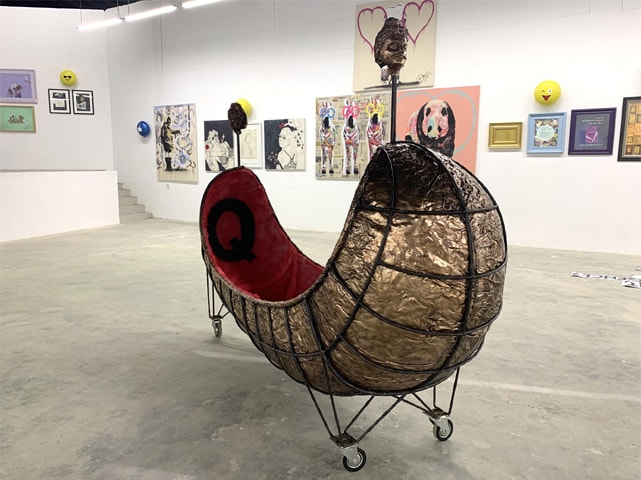
“Good art can boost your social status. Be good, buy good art. Buy a drawing room diamond,” says Emaan Mahmud aka Champa. The statement pretty much encapsulates her curatorial debut at Sanat Gallery in Karachi for a show titled Drawing Room Diamonds. Champa is a “Trophy wife, art collector and curator” part of the “socially conscious socialites.”
To elucidate, Champa also happens to be a completely fictional character, created by Mahmud for her satirical online blog that pokes fun at the elitist, self-appointed patrons of art, presumably driving the art world without much of a real understanding of it. She aims to “revolutionise” the art world through reality TV shows by making it more palatable for the mainstream — interestingly relevant to the recent events at KB19.
The show’s deliberately clunky curatorial statement and a crowded display set the tone for the show.
The catalogue for the show uses satire to deconstruct the ways in which art is viewed. It “explains” art through meaningless intellectual debate, masking genuine critique in such an intelligent and layered conversational format that a lot of it can be easily missed.
A group show critiques elitism and power dynamics within the art world
The socialites continually ask pseudo-intellectual questions such as, “Is art even art if it has copies?” or “Can photographs ever be good art?” The important human rights issues and social justice movements are reduced to mere fads and “isms” to gain social status. The intellectual socialite, Dr Molly, only pipes in to point out the gender imbalance in the show, never really offering much else in the way of commentary on the actual works.

The works included seem to be many of the usual suspects that are a crucial inclusion in any group show, and the reasons pointed out by the curator are all the wrong ones. Certain works such as the miniatures by Atif Khan are chosen for being “pretty”, others for boosting the rich collector’s ego with humiliated subjects such as the old woman in a torn bra by Maria Khan, which completely misinterprets the point of the work. Renowned artists such as Ali Kazim and R.M. Naeem are turned into status symbols, their value judged by their “social and financial return on investment”, regardless of the work.
Artworks are not seen as holding any meaning on their own but more in terms of what they can say about those who buy and display them. Cyra Ali’s provocative feminist overtones allow the otherwise misogynistic rich socialite to show his friends that he is a feminist, while including “tasteful nudes” is a way for Champa to tell people she is open-minded.
The show also critiques the practice of demeaning art and reducing it to mere spectacle as Champa attempts to show off her purchases. At one point, she wonders whether Amin Gulgee performs at parties, whether Zulfiqar Ali Bhutto will make her a kameez and makes plans to wear Saba Khan’s calligraphic “jewellery” to a milad. She is apparently unaware of the fact that Khan’s tongue-in-cheek works are typically a critique of the very social elitism that Champa embodies.

As Champa and the socialites extract their own meaning and agenda from the work, the artist’s own motivations recede into the background and become irrelevant. In this context, the question posed by the wall text, “is it still art if it’s not up on a rich man’s wall?” becomes highly pertinent.
“Drawing Room Diamonds” was on display at Sanat Gallery in Karachi from November 8 to November 28, 2019
Published in Dawn, EOS, December 1st, 2019














































Dear visitor, the comments section is undergoing an overhaul and will return soon.